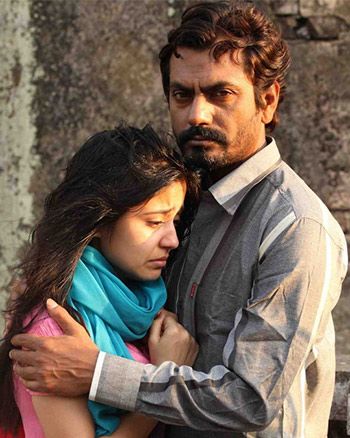Sreehari Nair explains why Haraamkhor may just be the most liberating Hindi movie made since Hazaaron Khwaishen Aisi.
 Haraamkhor may just be the most liberating Hindi movie made since Hazaaron Khwaishen Aisi.
Haraamkhor may just be the most liberating Hindi movie made since Hazaaron Khwaishen Aisi.
Much like Sudhir Mishra's 2005 masterpiece, Shlok Sharma's debut film doesn't once pause to exposit the world of its characters; on the contrary, it consistently catches its characters in a state of throbbing -- emotions jutting out, ready to act on their impulses.
I saw it on a Sunday evening, amid pools of laughter followed by long stretches of attentive silence.
The audience seemed stunned not by the explicitness of the movie's content, but in the way it was making them confront their own viewing presets.
Lesser Indian pictures have been piping in bold drama -- made palatable by a third act which effectively told us how too much of boldness can be bad for the conscience.
Haraamkhor's boldness, its emotional violence, is merely an outgrowth of the way its characters talk, feel, and behave.
Nawazuddin Siddiqui's Shyam Tekchand is a teacher who works out his physical desires on a student (Shweta Tripathi's Sandhya) by breaking down the rituals of seduction into little lessons.
He is Humbert Humbert without the guilt; she is Jeanne from Last Tango in Paris, with a school bag standing in for the fur-collared coat.
They meet near an electric mill, where he does a few formal gyrations, while she waits patiently for him to hit the opportune feeling.
It's her pining for him that charges him. He wants to know what he is to her; her inability to come up with a definite answer gives their sex an element of danger which he so craves.
Outside this private erotic space, we see them together through the eyes of two kids, Kamal and Mintu, who regard Sandhya's infatuation for Shyam with personal interest and as a great subject for revising their understanding of the adult world.
When Sandhya and Shyam are not seeing each other, they are in their regular lives -- Sandhya living at her motherless house with a father whose sole ownership she's afraid she'll lose, and Shyam with his wife Sunitha, their domestic scenes full of teasing and slapping each other on their behinds and thighs.
When Shyam and Sandhya are together, they're basically role-playing, while fulfilling their inherent need to be the governing man and the subservient woman respectively.
Nawazuddin's persistent clasping of his arm behind his back is a nod to the fake display of self-restraint that have long defined the public images of rural Tomcats -- men with feudal hang-ups who would spend their days on armchairs stopping only to deposit chewed-up betel leaves into their spittoons or to bellow lectures on human decency to the young, and who got their kicks out of impregnating timid petticoat-wearing housemaids at night by the giant pickle jars.
Sandhya is unaware of this culture of silent exploitation.
She's a policeman's daughter, a today's woman, and there's an oedipal angle to her attraction and he knows this truth and is both drawn to and repelled by it.
When he massages her, she recounts a memory of her father and he debases it by sleeping with her and instructing her to pull up her leggings once he's done.
When he can't answer her valid questions, he iterates his seniority, and at one point tells her, "Sambandh wagarey badon ki baatein hai" ("Why bother yourself with relationships? Those are topics for grown-ups").
What Nawazuddin Siddiqui as Shyam straddles with great comic effect is the divide that exists between his personal longings and his public facade: He has an eternal tingling in his loins, but cannot help asking his students to do the right things.
In movie after movie, here's an actor who brings us up close with the most loathsome characters by stripping them off their natural genre-implied attributes.
To appreciate his performances, we may have to go beyond the template emotions we're used to feeling at the movies; he goes deep down only so that he can dredge up visceral responses from us almost every time.
In a movie like Bajrangi Bhaijaan, for which he won a lot of undeserved applause, he was merely going through the drill, and the appreciation then was for how comforting his presence felt, just that one time.
When he's really at it though, Nawaz gives the audience an accelerated history of people and personality-types.
Through his improvisations, he doesn't just point us to the charm of his characters, he also conveys how sad and pathetic they are in their moment-to-moment existence.
In this movie, some of his simple actions seem to have attained a level of sculptural refinement -- his slouch has the grace of De Niro's sneer.
Shlok Sharma here has conceived Shyam from the many things Nawazuddin has done in the past, but the director-actor duo also together use these various elements to fashion a wholly new character.
Shyam is a haraamkhor not because he's vile, but because he pitifully attempts to cloak his vileness with grand life lessons and strict demarcations of what's good and what's bad.
And when Shyam fails to achieve the standards he lays down for others, we know he's feeling the burns himself.
After setting a date with Sandhya he stops to mumble "Scent lagaake aana," before turning to a teacher and saying in the same breath, "Tiwariji namaskaar."
What the children in the movie mercifully lack is Shyam's sense of convenience. They relish his filthy humour but take his teacher-like ramblings as mere platitudes to be heard and forgotten.
It's the children who are openly immoral, in a world where adults ramble on about lost childhoods, and where 'learning' is something to be done from 7 am to 1 pm, and later from 5 pm to 6 pm.
The children work outside all codes, and derive their happiness from myths and hearsays. Master Irfan Khan has the face of a Satyajit Ray kid, and Mohammed Samad is like a young Augie March -- he is the first to knock, first admitted.
Kamal and Mintu upset Shyam's orderly home, puncture his bicycle, and cross-talk despite his warnings.
The children in Haraamkhor wrestle with adults as if they are their equal, and are totally aware of their weak spots and conceits.
In a scene set in a restaurant, which calls to mind Jodie Foster and Robert De Niro's diner scene in Taxi Driver, Shyam desperately tries to summon a tough guy image and Sandhya catches him out with her gummy mocking laughter.
Shlok Sharma, when directing them, lets the children have their way; they sometimes smile at the camera when saying their lines.
The colours in the movie for the most part, suggest either an overcast look or the golden hour look -- it's either the colour of flesh or innocence.
Sharma, clearly working on a limited budget here, sees the landscape primarily in terms of passing smiles and clashing elements.
It's a world of domestic tensions crossing over into classroom chaos and of discovering tranquility in the most surprising places; it's a world of mismatched couples: Kamal & Sandhya, Sandhya & Shyam, Sandhya's father & and his second wife, Rainwater & Tarpaulin.
The interiors often reflect the characters' primitive artistic tastes and also their rehearsed lives; a birthday table plays host to a pineapple cake, a can of rasgulla and a Frooti bottle.
There's nothing like the Freytag's Pyramid of rising action, falling action, and denouement and it's often a simple cut to the windmills that signify a shifting of dramatic plateaus.
The camera is mounted as a constant companion to the actors (Sharma is a director of faces) and the grainy, shaky frames have the quality of home videos.
31-year-old Shweta Tripathi playing the 14-year-old Sandhya is perhaps the true spirit of the movie. Tripathi's natural face is frequently on the edge of a guffaw and from that curve she mines out her character's corrupt purity.
When wearing her hair in schoolgirl braids she works up an air of uptightness which she seems to magically dispel when her hair's held back using a band.
Her paroxysms are a sum of her conflicted feelings, and her full-bodied, open laughter expresses her comforts.
As Nawazuddin's Shyam fumbles and fumes, Sandhya stares purposefully at the horizon, as if she's fighting the wind, and we realise she's actually discovering her inner reserves of strength.
Shweta Tripathi and Shlok Sharma never make Sandhya consciously tough -- she chides, she smolders -- because in life it's the tender girls who always triumph over men like Shyam, and hop past them without any scruples.
By the end of the movie, the dark hovering clouds have rained themselves out, and Sandhya has grown out of her imprisonments.
This is her Bildungsroman.
Hzaraamkhor is sure to have its set of detractors because most of the 'morally dangerous' stuff in the movie plays out like comedy of manners.
Given the prim nature of movies that won mass appreciation last year, it's tough to imagine a picture like this -- which has no cheerful prose-for-the-masses (Misogyny must be shamed!) running through it -- gathering the interest it truly deserves.
There might be some who'd dismiss it as an imperfect movie, which it is, with its loose ends and the low budget working persistently to throttle its vividness.
But for me, who found it difficult to respond in any way to a movie like Pink which solely existed to think on my behalf, this was just the perfect medicine.
For those who are too easily scandalised, the Censor Board has a message in it for you, which describes the picture as a cautionary tale that must be viewed as just that ('Don't get too excited by what you see; for this is deplorable stuff').
But life isn't so facile, and movies and books that try to get at something complex are maybe one of the few things truly capable of extending our bounds of sympathy; the rest is just marketing.
This is the nature of all good art: Descriptions and easy classifications only condense their range of meaning.
While that truth may seem strange to some, there it is -- Truth is stranger than a Disclaimer.










